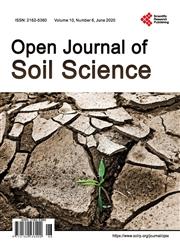Carbon Sequestration in Soil Aggregates under Different Cropping Patterns of Bangladesh
引用次数: 2
Abstract
Land use change and cropping patterns are important factors for controlling carbon sequestration in soils and they may also change the relative importance of different mechanisms of soil organic matter stabilization. The study was conducted to investigate the state of carbon sequestration in soil aggregates under different cropping patterns of Khulna, Jessore and Chapainawabganj districts in Bangladesh. Thirty-six soil samples were collected from (0 - 100 cm depth) above mentioned regions of three physiographic regions: Ganges Meander Floodplain, Ganges Tidal Floodplain and High Barind Tract. The texture of the samples varied within three soil texture groups, Silt Loam, Silty Clay Loam and Silty Clay. The highest NSI value (0.89) was found under Wheat-Fallow-T. Aman cropping pattern in Silty Clay soils (sample No 15) and lowest value (0.59) was found Vegetables/Mustard-Fallow-T. Aman cropping pattern in Silt Loam soils (sample No 17). The highest value (735.20 mg•kg−1) of active C was observed under Chickpea/mustard-T. Aman (Sample No 31) and the lowest value (619.23 mg•kg−1) was found in case of Wheat-Fallow-T. Aman cropping pattern (Sample No 30). The highest SOC stock (1.62 Kg C m−2) was found in Silty Clay Loam soil under Mungbean/Ash gourd-T. Aman cropping pattern (Sample no 4) and the lowest SOC stock (0.35 Kg C m−2) was found in Silt Loam soil under Cauliflower/Pumkin/Spinach-T. Aman Cropping pattern (Sample No 2). Soil organic carbon associated with different size aggregates was the highest (3.14%) under Mungbean/Ash gourd-T. Aman (Sample No 20) and was the lowest (0.36%) under Cauliflower/Pumkin/Spinach-T. Aman cropping pattern (Sample No 2). Organic carbon content in aggregate size ranges > 2000 μm (SOC1), 2000 - 250 μm (SOC2), 250-53 μm (SOC3), and 2000 μm, 2000 - 250 μm and 250 - 53 μm, aggregates. Significant positive correlations were found between SOC stock and SOC1, SOC stock and SOC2, SOC stock and SOC3, SOC stock and SOC4.孟加拉国不同种植方式下土壤团聚体的碳截留
土地利用变化和种植模式是控制土壤固碳的重要因素,它们也可能改变不同土壤有机质稳定机制的相对重要性。本研究旨在调查孟加拉国Khulna、Jessore和Chapainawabganj地区不同种植模式下土壤团聚体的固碳状态。从上述三个自然地理区域(0-100 cm深度)采集了36个土壤样本:恒河弯曲洪泛平原、恒河潮汐洪泛平原和高巴林域。样品的质地在三个土壤质地组内变化,即粉质壤土、粉质粘土壤土和粉质粘土。NSI值最高(0.89)是在Wheat-Flow-T下发现的。在粉质粘土(样品编号15)中发现了Aman种植模式,最低值(0.59)为蔬菜/芥末-Fallow-T。粉质壤土中的阿曼种植模式(样品编号17)。活性C的最高值(735.20 mg•kg−1)出现在鹰嘴豆/芥末-T。Aman(样品编号31),在Wheat-Flow-T病例中发现最低值(619.23 mg•kg−1)。阿曼种植模式(样品编号30)。在Mungbean/Ash gourd-T下的粉质粘土壤土中发现了最高的SOC存量(1.62 Kg C m−2)。在花椰菜/南瓜/菠菜-T下的粉质壤土中发现了Aman种植模式(4号样品)和最低SOC存量(0.35 Kg C m−2)。Aman裁剪图案(样品编号2)。与不同粒径团聚体相关的土壤有机碳在绿豆/灰沟-T条件下最高(3.14%)。Aman(样品编号20),在花椰菜/南瓜/菠菜-T下最低(0.36%)。阿曼种植模式(样本2)。骨料粒径中的有机碳含量范围>2000μm(SOC1)、2000-250μm(SOC2)、250-53μm(SOC 3)以及2000μm、2000-25μm和250-53µm骨料。SOC存量与SOC1、SOC存量与SOC 2、SOC存量和SOC 3、SOC存量及SOC 4呈正相关。
本文章由计算机程序翻译,如有差异,请以英文原文为准。
求助全文
约1分钟内获得全文
求助全文

 求助内容:
求助内容: 应助结果提醒方式:
应助结果提醒方式:


